(All information courtesy of the instrument teams.)
![]() Previous IAU Circulars
Previous IAU Circulars
TITLE: GCN/INTEGRAL NOTICE
NOTICE_DATE: Sat 07 Sep 13 21:40:37 UT
NOTICE_TYPE: INTEGRAL SPI ACS Trigger
TRIGGER_NUM: 6936, Sub_Num: 0
GRB_INTEN: 9.05 [sigma]
GRB_TIME: 77956.79 SOD {21:39:16.79} UT
GRB_DATE: 16542 TJD; 250 DOY; 13/09/07
COMMENTS: INTEGRAL SPI_ACS GRB Trigger.
COMMENTS: Time_Scale=2.0000 and Time_Error=1.0000.
COMMENTS: The SPIACS lightcurve can be found at:
COMMENTS: ftp://isdcarc.unige.ch/arc/FTP/ibas/spiacs/2013-09/2013-09-07T21-39-16.5617-19084-56208-0.lc
TITLE: GCN/SWIFT NOTICE
NOTICE_DATE: Sat 07 Sep 13 21:41:35 UT
NOTICE_TYPE: Swift-BAT GRB Position
TRIGGER_NUM: 569992, Seg_Num: 0
GRB_RA: 215.877d {+14h 23m 31s} (J2000),
216.007d {+14h 24m 02s} (current),
215.403d {+14h 21m 37s} (1950)
GRB_DEC: +45.616d {+45d 36' 58"} (J2000),
+45.554d {+45d 33' 16"} (current),
+45.842d {+45d 50' 32"} (1950)
GRB_ERROR: 3.00 [arcmin radius, statistical only]
GRB_INTEN: 2206 [cnts] Image_Peak=177 [image_cnts]
TRIGGER_DUR: 0.064 [sec]
TRIGGER_INDEX: 10427 E_range: 50-350 keV
BKG_INTEN: 149136 [cnts]
BKG_TIME: 78060.99 SOD {21:41:00.99} UT
BKG_DUR: 8 [sec]
GRB_DATE: 16542 TJD; 250 DOY; 13/09/07
GRB_TIME: 78072.83 SOD {21:41:12.83} UT
GRB_PHI: -156.86 [deg]
GRB_THETA: 9.22 [deg]
SOLN_STATUS: 0x43
RATE_SIGNIF: 18.84 [sigma]
IMAGE_SIGNIF: 9.91 [sigma]
MERIT_PARAMS: +1 +0 +0 -4 +3 +0 +0 +0 -52 +0
SUN_POSTN: 166.57d {+11h 06m 18s} +5.75d {+05d 44' 48"}
SUN_DIST: 58.36 [deg] Sun_angle= -3.3 [hr] (East of Sun)
MOON_POSTN: 192.55d {+12h 50m 11s} -7.76d {-07d 45' 24"}
MOON_DIST: 57.31 [deg]
MOON_ILLUM: 6 [%]
GAL_COORDS: 84.32, 64.00 [deg] galactic lon,lat of the burst (or transient)
ECL_COORDS: 189.20, 54.96 [deg] ecliptic lon,lat of the burst (or transient)
COMMENTS: SWIFT-BAT GRB Coordinates.
COMMENTS: This is a rate trigger.
COMMENTS: A point_source was found.
COMMENTS: This does not match any source in the on-board catalog.
COMMENTS: This does not match any source in the ground catalog.
COMMENTS: This is a GRB.
COMMENTS: This trigger occurred during a high background rate interval.
COMMENTS: This trigger occurred at longitude,latitude = 176.28,18.56 [deg].
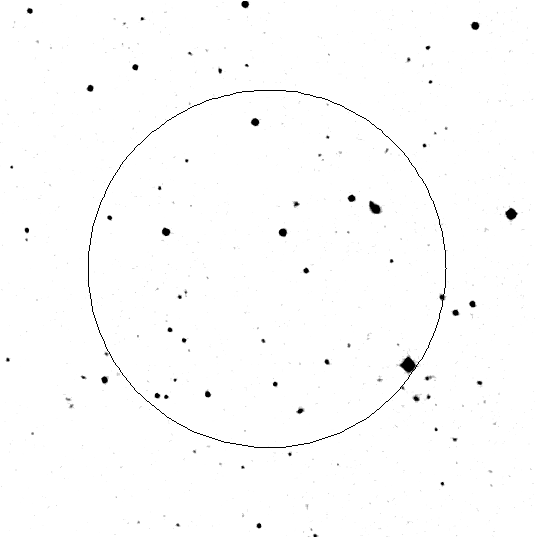
TITLE: GCN/SWIFT NOTICE
NOTICE_DATE: Sat 07 Sep 13 21:42:58 UT
NOTICE_TYPE: Swift-XRT Position
TRIGGER_NUM: 569992, Seg_Num: 0
GRB_RA: 215.8926d {+14h 23m 34.22s} (J2000),
216.0223d {+14h 24m 05.35s} (current),
215.4185d {+14h 21m 40.44s} (1950)
GRB_DEC: +45.6094d {+45d 36' 33.8"} (J2000),
+45.5477d {+45d 32' 51.8"} (current),
+45.8356d {+45d 50' 08.2"} (1950)
GRB_ERROR: 5.0 [arcsec radius, statistical plus systematic, 90% containment]
GRB_INTEN: 6.33e-08 [erg/cm2/sec]
GRB_SIGNIF: 8.18 [sigma]
IMG_START_DATE: 16542 TJD; 250 DOY; 13/09/07
IMG_START_TIME: 78139.39 SOD {21:42:19.39} UT, 66.6 [sec] since BAT Trigger Time
TAM[0-3]: 327.67 237.21 261.49 243.39
AMPLIFIER: 2
WAVEFORM: 134
SUN_POSTN: 166.58d {+11h 06m 18s} +5.75d {+05d 44' 47"}
SUN_DIST: 58.37 [deg] Sun_angle= -3.3 [hr] (East of Sun)
MOON_POSTN: 192.56d {+12h 50m 14s} -7.76d {-07d 45' 38"}
MOON_DIST: 57.31 [deg]
MOON_ILLUM: 6 [%]
GAL_COORDS: 84.30, 64.00 [deg] galactic lon,lat of the burst
ECL_COORDS: 189.22, 54.96 [deg] ecliptic lon,lat of the burst
COMMENTS: SWIFT-XRT Coordinates.
COMMENTS: The XRT position is 0.74 arcmin from the BAT position.
TITLE: GCN/SWIFT NOTICE
NOTICE_DATE: Sat 07 Sep 13 21:43:09 UT
NOTICE_TYPE: Swift-XRT Image
TRIGGER_NUM: 569992, Seg_Num: 0
GRB_RA: 215.8926d {+14h 23m 34.2s} (J2000),
216.0223d {+14h 24m 05.3s} (current),
215.4185d {+14h 21m 40.4s} (1950)
GRB_DEC: +45.6094d {+45d 36' 33.8"} (J2000),
+45.5477d {+45d 32' 51.8"} (current),
+45.8356d {+45d 50' 08.2"} (1950)
GRB_ERROR: 4.7 [arcsec, radius, statistical plus systematic]
GRB_INTEN: 67 [cnts]
IMG_START_DATE: 16542 TJD; 250 DOY; 13/09/07
IMG_START_TIME: 78139.39 SOD {21:42:19.39} UT, 66.6 [sec] since BAT Trigger Time
CENTROID_X: 294.38, raw= 294 [pixels]
CENTROID_Y: 316.12, raw= 316 [pixels]
ROLL: 242.46 [deg]
GAIN: 1
MODE: 2, Short Image mode
WAVEFORM: 134
EXPO_TIME: 0.10 [sec]
GRB_POS_XRT_Y: 42.72
GRB_POS_XRT_Z: -21.95
IMAGE_URL: sw00569992000msxps_rw.img
SUN_POSTN: 166.58d {+11h 06m 18s} +5.75d {+05d 44' 47"}
SUN_DIST: 58.37 [deg] Sun_angle= -3.3 [hr] (East of Sun)
MOON_POSTN: 192.56d {+12h 50m 14s} -7.76d {-07d 45' 40"}
MOON_DIST: 57.31 [deg]
MOON_ILLUM: 6 [%]
GAL_COORDS: 84.30, 64.00 [deg] galactic lon,lat of the burst
ECL_COORDS: 189.22, 54.96 [deg] ecliptic lon,lat of the burst
COMMENTS: SWIFT-XRT Image.

TITLE: GCN/SWIFT NOTICE
NOTICE_DATE: Sat 07 Sep 13 21:43:28 UT
NOTICE_TYPE: Swift-XRT Processed Image
TRIGGER_NUM: 569992, Seg_Num: 0
GRB_RA: 215.8926d {+14h 23m 34.2s} (J2000),
216.0223d {+14h 24m 05.3s} (current),
215.4185d {+14h 21m 40.4s} (1950)
GRB_DEC: +45.6094d {+45d 36' 33.8"} (J2000),
+45.5477d {+45d 32' 51.8"} (current),
+45.8356d {+45d 50' 08.2"} (1950)
GRB_ERROR: 4.7 [arcsec, radius, statistical plus systematic]
GRB_INTEN: 67 [cnts]
IMG_START_DATE: 16542 TJD; 250 DOY; 13/09/07
IMG_START_TIME: 78139.39 SOD {21:42:19.39} UT, 66.6 [sec] since BAT Trigger Time
CENTROID_X: 294.38, raw= 294 [pixels]
CENTROID_Y: 316.12, raw= 316 [pixels]
ROLL: 242.46 [deg]
GAIN: 1
MODE: 2, Short Image mode
WAVEFORM: 134
EXPO_TIME: 0.10 [sec]
GRB_POS_XRT_Y: 42.72
GRB_POS_XRT_Z: -21.95
IMAGE_URL: sw00569992000msxps_rw.img
SUN_POSTN: 166.58d {+11h 06m 18s} +5.75d {+05d 44' 46"}
SUN_DIST: 58.37 [deg] Sun_angle= -3.3 [hr] (East of Sun)
MOON_POSTN: 192.56d {+12h 50m 15s} -7.76d {-07d 45' 43"}
MOON_DIST: 57.31 [deg]
MOON_ILLUM: 6 [%]
GAL_COORDS: 84.30, 64.00 [deg] galactic lon,lat of the burst
ECL_COORDS: 189.22, 54.96 [deg] ecliptic lon,lat of the burst
COMMENTS: SWIFT-XRT Processed Image.

TITLE: GCN/SWIFT NOTICE
NOTICE_DATE: Sat 07 Sep 13 21:44:59 UT
NOTICE_TYPE: Swift-BAT GRB Lightcurve
TRIGGER_NUM: 569992, Seg_Num: 0
GRB_RA: 215.877d {+14h 23m 31s} (J2000),
216.007d {+14h 24m 02s} (current),
215.403d {+14h 21m 37s} (1950)
GRB_DEC: +45.616d {+45d 36' 58"} (J2000),
+45.554d {+45d 33' 16"} (current),
+45.842d {+45d 50' 32"} (1950)
GRB_DATE: 16542 TJD; 250 DOY; 13/09/07
GRB_TIME: 78073.08 SOD {21:41:13.08} UT
TRIGGER_INDEX: 10427
GRB_PHI: -156.86 [deg]
GRB_THETA: 9.22 [deg]
DELTA_TIME: 70.00 [sec]
TRIGGER_DUR: 0.064 [sec]
SOLN_STATUS: 0x43
RATE_SIGNIF: 18.84 [sigma]
IMAGE_SIGNIF: 9.91 [sigma]
LC_URL: sw00569992000msb.lc
SUN_POSTN: 166.58d {+11h 06m 19s} +5.75d {+05d 44' 45"}
SUN_DIST: 58.36 [deg] Sun_angle= -3.3 [hr] (East of Sun)
MOON_POSTN: 192.58d {+12h 50m 18s} -7.77d {-07d 45' 59"}
MOON_DIST: 57.31 [deg]
MOON_ILLUM: 6 [%]
GAL_COORDS: 84.32, 64.00 [deg] galactic lon,lat of the burst (or transient)
ECL_COORDS: 189.20, 54.96 [deg] ecliptic lon,lat of the burst (or transient)
COMMENTS: SWIFT-BAT GRB Lightcurve.
COMMENTS:
COMMENTS: The next comments were copied from the BAT_POS Notice:
COMMENTS: This is a rate trigger.
COMMENTS: A point_source was found.
COMMENTS: This does not match any source in the on-board catalog.
COMMENTS: This does not match any source in the ground catalog.
COMMENTS: This is a GRB.
COMMENTS: This trigger occurred during a high background rate interval.
COMMENTS: This trigger occurred at longitude,latitude = 176.28,18.56 [deg].
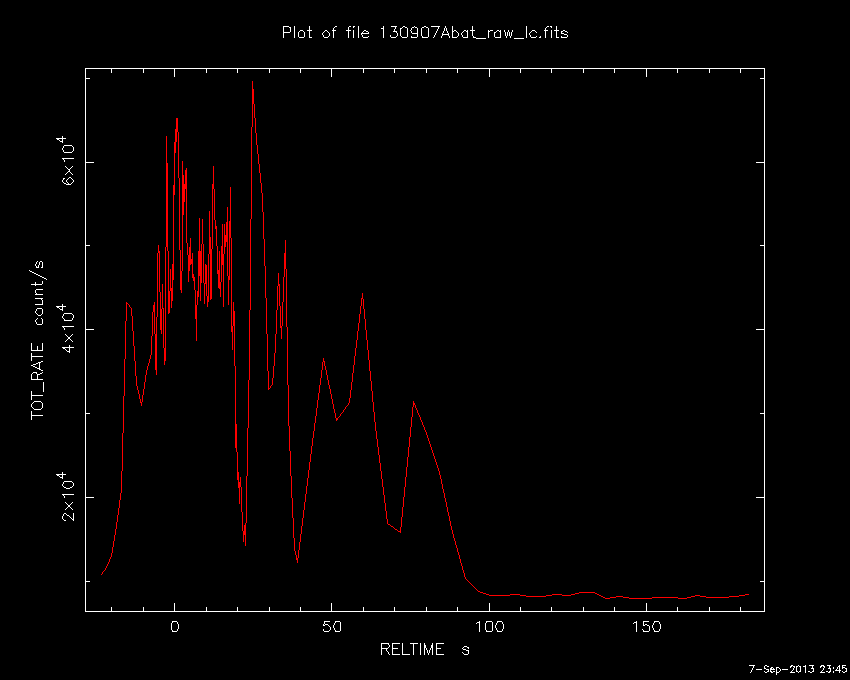
TITLE: GCN/SWIFT NOTICE
NOTICE_DATE: Sat 07 Sep 13 21:46:14 UT
NOTICE_TYPE: Swift-UVOT Source List
TRIGGER_NUM: 569992, Seg_Num: 0
POINT_RA: 215.893d {+14h 23m 34s} (J2000)
POINT_DEC: +45.621d {+45d 37' 16"} (J2000)
POINT_ROLL: 242.458d
IMG_START_DATE: 16542 TJD; 250 DOY; 13/09/07
IMG_START_TIME: 78147.19 SOD {21:42:27.19} UT, 74.4 [sec] since BAT Trigger Time
FILTER: 10, White
BKG_MEAN: 5.008
N_STARS: 13
X_OFFSET: 544 [pixels]
Y_OFFSET: 504 [pixels]
X_MAX: 1503 [pixels]
Y_MAX: 1463 [pixels]
DET_THRESH: 19
PHOTO_THRESH: 11
SL_URL: sw00569992000msufc0074.fits
SUN_POSTN: 166.58d {+11h 06m 19s} +5.75d {+05d 44' 44"}
SUN_DIST: 58.37 [deg] Sun_angle= -3.3 [hr] (East of Sun)
MOON_POSTN: 192.59d {+12h 50m 21s} -7.77d {-07d 46' 12"}
MOON_DIST: 57.32 [deg]
MOON_ILLUM: 6 [%]
GAL_COORDS: 84.32, 63.99 [deg] galactic lon,lat of the pointing direction
ECL_COORDS: 189.21, 54.97 [deg] ecliptic lon,lat of the pointing direction
COMMENTS: SWIFT-UVOT Source List.
TITLE: GCN/SWIFT NOTICE
NOTICE_DATE: Sat 07 Sep 13 21:46:42 UT
NOTICE_TYPE: Swift-UVOT Processed Source List
TRIGGER_NUM: 569992, Seg_Num: 0
POINT_RA: 215.893d {+14h 23m 34s} (J2000)
POINT_DEC: +45.621d {+45d 37' 16"} (J2000)
POINT_ROLL: 242.458d
IMG_START_DATE: 16542 TJD; 250 DOY; 13/09/07
IMG_START_TIME: 78147.19 SOD {21:42:27.19} UT, 74.4 [sec] since BAT Trigger Time
FILTER: 10, White
BKG_MEAN: 5.008
N_STARS: 13
X_OFFSET: 544 [pixels]
Y_OFFSET: 504 [pixels]
X_MAX: 1503 [pixels]
Y_MAX: 1463 [pixels]
DET_THRESH: 19
PHOTO_THRESH: 11
SL_URL: sw00569992000msufc0074.fits
SUN_POSTN: 166.58d {+11h 06m 19s} +5.75d {+05d 44' 43"}
SUN_DIST: 58.37 [deg] Sun_angle= -3.3 [hr] (East of Sun)
MOON_POSTN: 192.59d {+12h 50m 22s} -7.77d {-07d 46' 17"}
MOON_DIST: 57.32 [deg]
MOON_ILLUM: 6 [%]
GAL_COORDS: 84.32, 63.99 [deg] galactic lon,lat of the pointing direction
ECL_COORDS: 189.21, 54.97 [deg] ecliptic lon,lat of the pointing direction
COMMENTS: SWIFT-UVOT Processed Source List.
COMMENTS: All 4 attachments are included.
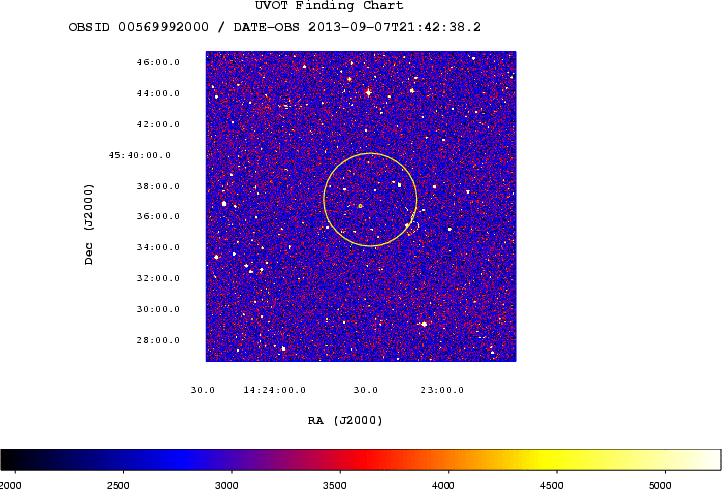
TITLE: GCN/SWIFT NOTICE
NOTICE_DATE: Sat 07 Sep 13 21:49:12 UT
NOTICE_TYPE: Swift-UVOT Image
TRIGGER_NUM: 569992, Seg_Num: 0
POINT_RA: 215.893d {+14h 23m 34s} (J2000)
POINT_DEC: +45.621d {+45d 37' 16"} (J2000)
ROLL: 242.458d
IMG_START_DATE: 16542 TJD; 250 DOY; 13/09/07
IMG_START_TIME: 78147.19 SOD {21:42:27.19} UT, 74.4 [sec] since BAT Trigger Time
FILTER: 10, White
EXPOSURE_ID: 400282958
X_OFFSET: 793 [pixels]
Y_OFFSET: 779 [pixels]
WIDTH: 160 [pixels]
HEIGHT: 160 [pixels]
X_GRB_POS: 953
Y_GRB_POS: 939
BINNING_INDEX: 1
IM_URL: sw00569992000msuni0086.fits
SUN_POSTN: 166.58d {+11h 06m 19s} +5.74d {+05d 44' 41"}
SUN_DIST: 58.37 [deg] Sun_angle= -3.3 [hr] (East of Sun)
MOON_POSTN: 192.61d {+12h 50m 27s} -7.78d {-07d 46' 42"}
MOON_DIST: 57.32 [deg]
MOON_ILLUM: 6 [%]
GAL_COORDS: 84.32, 63.99 [deg] galactic lon,lat of the pointing direction
ECL_COORDS: 189.21, 54.97 [deg] ecliptic lon,lat of the pointing direction
COMMENTS: SWIFT-UVOT Image.
COMMENTS: The GRB Position came from the XRT Position Command.
COMMENTS: The image has 2x2 binning (compression).
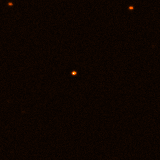
TITLE: GCN/SWIFT NOTICE
NOTICE_DATE: Sat 07 Sep 13 21:49:28 UT
NOTICE_TYPE: Swift-UVOT Processed Image
TRIGGER_NUM: 569992, Seg_Num: 0
POINT_RA: 215.893d {+14h 23m 34s} (J2000)
POINT_DEC: +45.621d {+45d 37' 16"} (J2000)
ROLL: 242.458d
IMG_START_DATE: 16542 TJD; 250 DOY; 13/09/07
IMG_START_TIME: 78147.19 SOD {21:42:27.19} UT, 74.4 [sec] since BAT Trigger Time
FILTER: 10, White
EXPOSURE_ID: 400282958
X_OFFSET: 793 [pixels]
Y_OFFSET: 779 [pixels]
WIDTH: 160 [pixels]
HEIGHT: 160 [pixels]
X_GRB_POS: 953
Y_GRB_POS: 939
BINNING_INDEX: 1
IM_URL: sw00569992000msuni0086.fits
SUN_POSTN: 166.58d {+11h 06m 19s} +5.74d {+05d 44' 41"}
SUN_DIST: 58.37 [deg] Sun_angle= -3.3 [hr] (East of Sun)
MOON_POSTN: 192.61d {+12h 50m 28s} -7.78d {-07d 46' 45"}
MOON_DIST: 57.32 [deg]
MOON_ILLUM: 6 [%]
GAL_COORDS: 84.32, 63.99 [deg] galactic lon,lat of the pointing direction
ECL_COORDS: 189.21, 54.97 [deg] ecliptic lon,lat of the pointing direction
COMMENTS: SWIFT-UVOT Processed Image.
COMMENTS: The GRB Position came from the XRT Position Command.
COMMENTS: The image has 2x2 binning (compression).
COMMENTS: All 4 attachments are included.
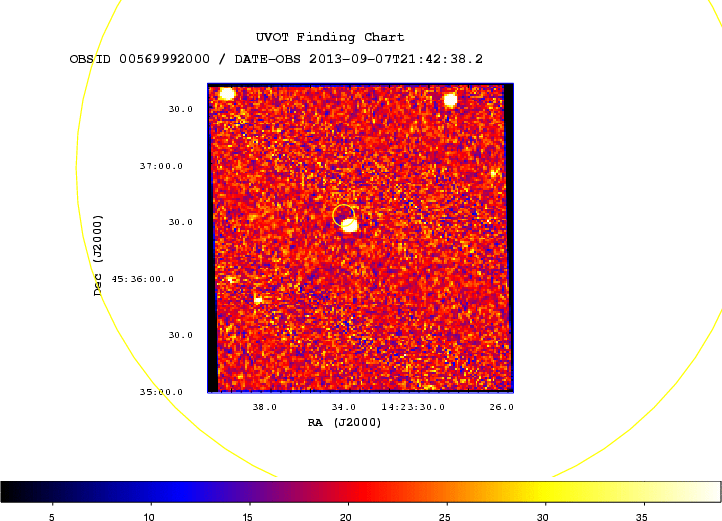
TITLE: GCN/SWIFT NOTICE
NOTICE_DATE: Sat 07 Sep 13 21:52:29 UT
NOTICE_TYPE: Swift-UVOT Position
TRIGGER_NUM: 569992, Seg_Num: 0
GRB_RA: 215.8918d {+14h 23m 34.03s} (J2000),
216.0215d {+14h 24m 05.15s} (current),
215.4177d {+14h 21m 40.24s} (1950)
GRB_DEC: +45.6075d {+45d 36' 27.0"} (J2000),
+45.5458d {+45d 32' 44.9"} (current),
+45.8337d {+45d 50' 01.3"} (1950)
GRB_ERROR: 0.6 [arcsec radius, statistical only]
GRB_MAG: 15.55 +/- 0.14 [mag]
FILTER: 10, White
IMG_START_DATE: 16542 TJD; 250 DOY; 13/09/07
IMG_START_TIME: 78146.00 SOD {21:42:26.00} UT, 73.2 [sec] since BAT Trigger Time
SUN_POSTN: 166.58d {+11h 06m 20s} +5.74d {+05d 44' 38"}
SUN_DIST: 58.36 [deg] Sun_angle= -3.3 [hr] (East of Sun)
MOON_POSTN: 192.64d {+12h 50m 34s} -7.79d {-07d 47' 16"}
MOON_DIST: 57.30 [deg]
MOON_ILLUM: 6 [%]
GAL_COORDS: 84.29, 64.00 [deg] galactic lon,lat of the burst (or transient)
ECL_COORDS: 189.23, 54.96 [deg] ecliptic lon,lat of the burst (or transient)
COMMENTS: SWIFT UVOT Position Notice.
COMMENTS: This Notice was ground-generated -- not flight-generated.
COMMENTS: The UVOT position is 7.2 arcsec from the XRT position.
COMMENTS: Result based on Genie data.
COMMENTS: Notice generated automatically.
TITLE: GCN/SWIFT NOTICE
NOTICE_DATE: Sat 07 Sep 13 21:53:51 UT
NOTICE_TYPE: Swift-UVOT Source List
TRIGGER_NUM: 569992, Seg_Num: 0
POINT_RA: 215.893d {+14h 23m 34s} (J2000)
POINT_DEC: +45.623d {+45d 37' 22"} (J2000)
POINT_ROLL: 242.455d
IMG_START_DATE: 16542 TJD; 250 DOY; 13/09/07
IMG_START_TIME: 78359.16 SOD {21:45:59.16} UT, 286.3 [sec] since BAT Trigger Time
FILTER: 7, U
BKG_MEAN: 1.520
N_STARS: 10
X_OFFSET: 473 [pixels]
Y_OFFSET: 459 [pixels]
X_MAX: 1432 [pixels]
Y_MAX: 1418 [pixels]
DET_THRESH: 10
PHOTO_THRESH: 5
SL_URL: sw00569992000msufc0286.fits
SUN_POSTN: 166.58d {+11h 06m 20s} +5.74d {+05d 44' 37"}
SUN_DIST: 58.37 [deg] Sun_angle= -3.3 [hr] (East of Sun)
MOON_POSTN: 192.65d {+12h 50m 37s} -7.79d {-07d 47' 30"}
MOON_DIST: 57.32 [deg]
MOON_ILLUM: 6 [%]
GAL_COORDS: 84.32, 63.99 [deg] galactic lon,lat of the pointing direction
ECL_COORDS: 189.21, 54.97 [deg] ecliptic lon,lat of the pointing direction
COMMENTS: SWIFT-UVOT Source List.
RA(J2000) = 14h 23m 31s Dec(J2000) = +45d 36' 58"with an uncertainty of 3 arcmin (radius, 90% containment, including systematic uncertainty). The BAT light curve showed a complex multi-peaked structure with a duration of about 120 sec. The peak count rate was ~60000 counts/sec (15-350 keV), at ~25 sec after the trigger.
RA(J2000) = +14h 23m 34.22s Dec(J2000) = +45d 36' 33.8"with an uncertainty of 5.0 arcseconds (radius, 90% containment). This location is 45 arcseconds from the BAT onboard position, within the BAT error circle. No event data are yet available to determine the column density using X-ray spectroscopy.
RA(J2000) = 14:23:34.03 = 215.89181 DEC(J2000) = +45:36:27.1 = 45.60753with a 90%-confidence error radius of about 0.61 arc sec. This position is 7.0 arc sec. from the center of the XRT error circle. The estimated magnitude is 15.55 with a 1-sigma error of about 0.14. No correction has been made for the expected extinction corresponding to E(B-V) of 0.01.
TITLE: GCN/SWIFT NOTICE
NOTICE_DATE: Sat 07 Sep 13 21:54:16 UT
NOTICE_TYPE: Swift-UVOT Processed Source List
TRIGGER_NUM: 569992, Seg_Num: 0
POINT_RA: 215.893d {+14h 23m 34s} (J2000)
POINT_DEC: +45.623d {+45d 37' 22"} (J2000)
POINT_ROLL: 242.455d
IMG_START_DATE: 16542 TJD; 250 DOY; 13/09/07
IMG_START_TIME: 78359.16 SOD {21:45:59.16} UT, 286.3 [sec] since BAT Trigger Time
FILTER: 7, U
BKG_MEAN: 1.520
N_STARS: 10
X_OFFSET: 473 [pixels]
Y_OFFSET: 459 [pixels]
X_MAX: 1432 [pixels]
Y_MAX: 1418 [pixels]
DET_THRESH: 10
PHOTO_THRESH: 5
SL_URL: sw00569992000msufc0286.fits
SUN_POSTN: 166.58d {+11h 06m 20s} +5.74d {+05d 44' 36"}
SUN_DIST: 58.37 [deg] Sun_angle= -3.3 [hr] (East of Sun)
MOON_POSTN: 192.66d {+12h 50m 38s} -7.79d {-07d 47' 35"}
MOON_DIST: 57.32 [deg]
MOON_ILLUM: 6 [%]
GAL_COORDS: 84.32, 63.99 [deg] galactic lon,lat of the pointing direction
ECL_COORDS: 189.21, 54.97 [deg] ecliptic lon,lat of the pointing direction
COMMENTS: SWIFT-UVOT Processed Source List.
COMMENTS: If you have elected to receive attachments:
COMMENTS: The uvot_catalog_srclist.fits.gz file does not exist; skipping the attachment.
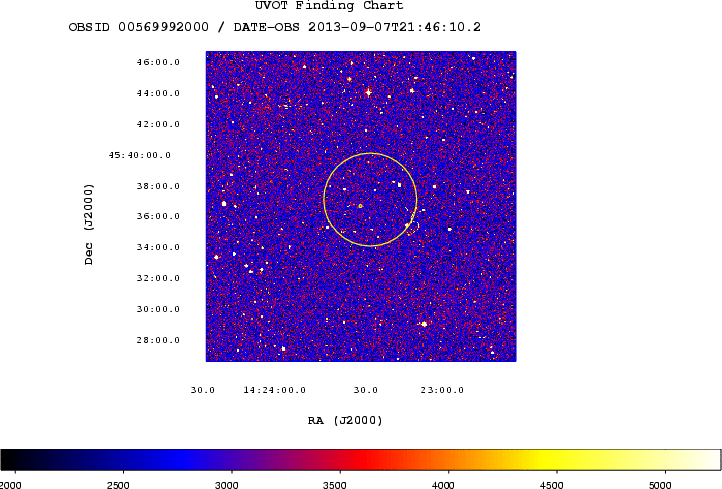
TITLE: GCN/SWIFT NOTICE
NOTICE_DATE: Sat 07 Sep 13 21:55:06 UT
NOTICE_TYPE: Swift-UVOT Image
TRIGGER_NUM: 569992, Seg_Num: 0
POINT_RA: 215.893d {+14h 23m 34s} (J2000)
POINT_DEC: +45.623d {+45d 37' 22"} (J2000)
ROLL: 242.455d
IMG_START_DATE: 16542 TJD; 250 DOY; 13/09/07
IMG_START_TIME: 78359.16 SOD {21:45:59.16} UT, 286.3 [sec] since BAT Trigger Time
FILTER: 7, U
EXPOSURE_ID: 400283170
X_OFFSET: 793 [pixels]
Y_OFFSET: 779 [pixels]
WIDTH: 160 [pixels]
HEIGHT: 160 [pixels]
X_GRB_POS: 953
Y_GRB_POS: 939
BINNING_INDEX: 1
IM_URL: sw00569992000msuni0298.fits
SUN_POSTN: 166.58d {+11h 06m 20s} +5.74d {+05d 44' 36"}
SUN_DIST: 58.37 [deg] Sun_angle= -3.3 [hr] (East of Sun)
MOON_POSTN: 192.66d {+12h 50m 39s} -7.80d {-07d 47' 43"}
MOON_DIST: 57.32 [deg]
MOON_ILLUM: 6 [%]
GAL_COORDS: 84.32, 63.99 [deg] galactic lon,lat of the pointing direction
ECL_COORDS: 189.21, 54.97 [deg] ecliptic lon,lat of the pointing direction
COMMENTS: SWIFT-UVOT Image.
COMMENTS: The GRB Position came from the XRT Position Command.
COMMENTS: The image has 2x2 binning (compression).

TITLE: GCN/SWIFT NOTICE
NOTICE_DATE: Sat 07 Sep 13 21:55:21 UT
NOTICE_TYPE: Swift-UVOT Processed Image
TRIGGER_NUM: 569992, Seg_Num: 0
POINT_RA: 215.893d {+14h 23m 34s} (J2000)
POINT_DEC: +45.623d {+45d 37' 22"} (J2000)
ROLL: 242.455d
IMG_START_DATE: 16542 TJD; 250 DOY; 13/09/07
IMG_START_TIME: 78359.16 SOD {21:45:59.16} UT, 286.3 [sec] since BAT Trigger Time
FILTER: 7, U
EXPOSURE_ID: 400283170
X_OFFSET: 793 [pixels]
Y_OFFSET: 779 [pixels]
WIDTH: 160 [pixels]
HEIGHT: 160 [pixels]
X_GRB_POS: 953
Y_GRB_POS: 939
BINNING_INDEX: 1
IM_URL: sw00569992000msuni0298.fits
SUN_POSTN: 166.58d {+11h 06m 20s} +5.74d {+05d 44' 35"}
SUN_DIST: 58.37 [deg] Sun_angle= -3.3 [hr] (East of Sun)
MOON_POSTN: 192.67d {+12h 50m 40s} -7.80d {-07d 47' 46"}
MOON_DIST: 57.32 [deg]
MOON_ILLUM: 6 [%]
GAL_COORDS: 84.32, 63.99 [deg] galactic lon,lat of the pointing direction
ECL_COORDS: 189.21, 54.97 [deg] ecliptic lon,lat of the pointing direction
COMMENTS: SWIFT-UVOT Processed Image.
COMMENTS: The GRB Position came from the XRT Position Command.
COMMENTS: The image has 2x2 binning (compression).
COMMENTS: All 4 attachments are included.
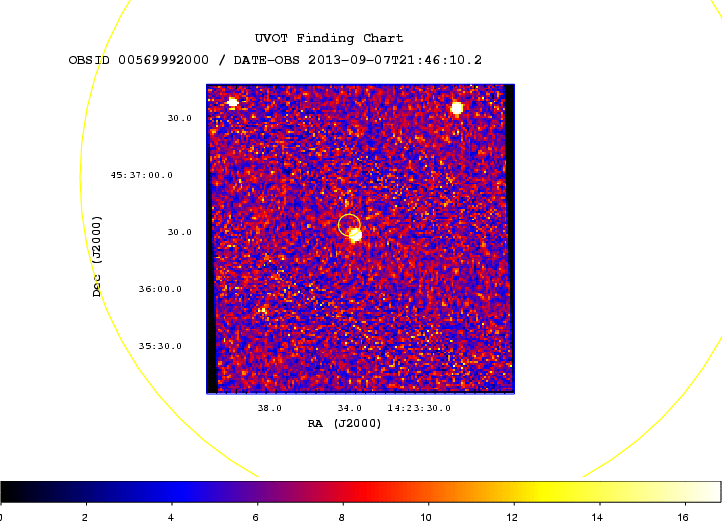
TITLE: GCN/SWIFT NOTICE
NOTICE_DATE: Sat 07 Sep 13 21:58:47 UT
NOTICE_TYPE: Swift-UVOT Source List
TRIGGER_NUM: 569992, Seg_Num: 0
POINT_RA: 215.893d {+14h 23m 34s} (J2000)
POINT_DEC: +45.623d {+45d 37' 22"} (J2000)
POINT_ROLL: 242.455d
IMG_START_DATE: 16542 TJD; 250 DOY; 13/09/07
IMG_START_TIME: 78937.78 SOD {21:55:37.78} UT, 864.9 [sec] since BAT Trigger Time
FILTER: 10, White
BKG_MEAN: 3.587
N_STARS: 31
X_OFFSET: 233 [pixels]
Y_OFFSET: 219 [pixels]
X_MAX: 1672 [pixels]
Y_MAX: 1658 [pixels]
DET_THRESH: 16
PHOTO_THRESH: 9
SL_URL: sw00569992000msufc0864.fits
SUN_POSTN: 166.59d {+11h 06m 21s} +5.74d {+05d 44' 32"}
SUN_DIST: 58.37 [deg] Sun_angle= -3.3 [hr] (East of Sun)
MOON_POSTN: 192.70d {+12h 50m 47s} -7.81d {-07d 48' 21"}
MOON_DIST: 57.32 [deg]
MOON_ILLUM: 6 [%]
GAL_COORDS: 84.32, 63.99 [deg] galactic lon,lat of the pointing direction
ECL_COORDS: 189.21, 54.97 [deg] ecliptic lon,lat of the pointing direction
COMMENTS: SWIFT-UVOT Source List.
TITLE: GCN/SWIFT NOTICE
NOTICE_DATE: Sat 07 Sep 13 21:59:12 UT
NOTICE_TYPE: Swift-UVOT Processed Source List
TRIGGER_NUM: 569992, Seg_Num: 0
POINT_RA: 215.893d {+14h 23m 34s} (J2000)
POINT_DEC: +45.623d {+45d 37' 22"} (J2000)
POINT_ROLL: 242.455d
IMG_START_DATE: 16542 TJD; 250 DOY; 13/09/07
IMG_START_TIME: 78937.78 SOD {21:55:37.78} UT, 864.9 [sec] since BAT Trigger Time
FILTER: 10, White
BKG_MEAN: 3.587
N_STARS: 31
X_OFFSET: 233 [pixels]
Y_OFFSET: 219 [pixels]
X_MAX: 1672 [pixels]
Y_MAX: 1658 [pixels]
DET_THRESH: 16
PHOTO_THRESH: 9
SL_URL: sw00569992000msufc0864.fits
SUN_POSTN: 166.59d {+11h 06m 21s} +5.74d {+05d 44' 32"}
SUN_DIST: 58.37 [deg] Sun_angle= -3.3 [hr] (East of Sun)
MOON_POSTN: 192.70d {+12h 50m 48s} -7.81d {-07d 48' 25"}
MOON_DIST: 57.32 [deg]
MOON_ILLUM: 6 [%]
GAL_COORDS: 84.32, 63.99 [deg] galactic lon,lat of the pointing direction
ECL_COORDS: 189.21, 54.97 [deg] ecliptic lon,lat of the pointing direction
COMMENTS: SWIFT-UVOT Processed Source List.
COMMENTS: All 4 attachments are included.
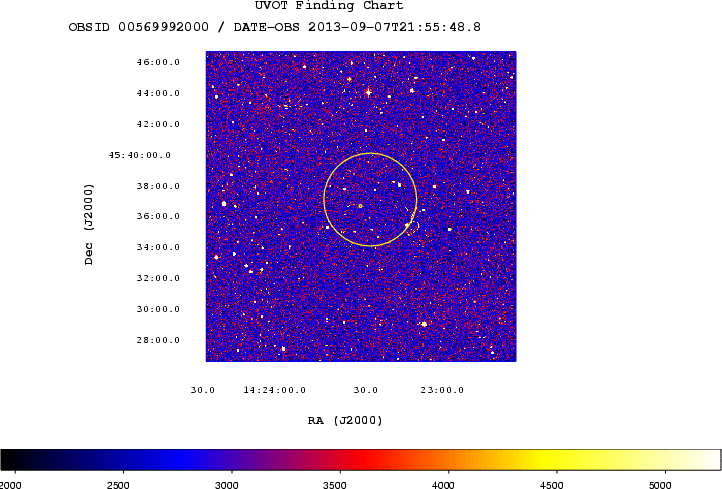
TITLE: GCN/SWIFT NOTICE
NOTICE_DATE: Sat 07 Sep 13 22:00:23 UT
NOTICE_TYPE: Swift-UVOT Image
TRIGGER_NUM: 569992, Seg_Num: 0
POINT_RA: 215.893d {+14h 23m 34s} (J2000)
POINT_DEC: +45.623d {+45d 37' 22"} (J2000)
ROLL: 242.455d
IMG_START_DATE: 16542 TJD; 250 DOY; 13/09/07
IMG_START_TIME: 78937.78 SOD {21:55:37.78} UT, 864.9 [sec] since BAT Trigger Time
FILTER: 10, White
EXPOSURE_ID: 400283748
X_OFFSET: 792 [pixels]
Y_OFFSET: 778 [pixels]
WIDTH: 160 [pixels]
HEIGHT: 160 [pixels]
X_GRB_POS: 952
Y_GRB_POS: 938
BINNING_INDEX: 1
IM_URL: sw00569992000msuni0876.fits
SUN_POSTN: 166.59d {+11h 06m 21s} +5.74d {+05d 44' 31"}
SUN_DIST: 58.37 [deg] Sun_angle= -3.3 [hr] (East of Sun)
MOON_POSTN: 192.71d {+12h 50m 51s} -7.81d {-07d 48' 38"}
MOON_DIST: 57.32 [deg]
MOON_ILLUM: 6 [%]
GAL_COORDS: 84.32, 63.99 [deg] galactic lon,lat of the pointing direction
ECL_COORDS: 189.21, 54.97 [deg] ecliptic lon,lat of the pointing direction
COMMENTS: SWIFT-UVOT Image.
COMMENTS: The GRB Position came from the Window Position in the Mode Command.
COMMENTS: The image has 2x2 binning (compression).
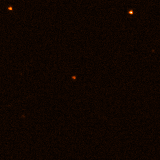
TITLE: GCN/SWIFT NOTICE
NOTICE_DATE: Sat 07 Sep 13 22:00:41 UT
NOTICE_TYPE: Swift-UVOT Processed Image
TRIGGER_NUM: 569992, Seg_Num: 0
POINT_RA: 215.893d {+14h 23m 34s} (J2000)
POINT_DEC: +45.623d {+45d 37' 22"} (J2000)
ROLL: 242.455d
IMG_START_DATE: 16542 TJD; 250 DOY; 13/09/07
IMG_START_TIME: 78937.78 SOD {21:55:37.78} UT, 864.9 [sec] since BAT Trigger Time
FILTER: 10, White
EXPOSURE_ID: 400283748
X_OFFSET: 792 [pixels]
Y_OFFSET: 778 [pixels]
WIDTH: 160 [pixels]
HEIGHT: 160 [pixels]
X_GRB_POS: 952
Y_GRB_POS: 938
BINNING_INDEX: 1
IM_URL: sw00569992000msuni0876.fits
SUN_POSTN: 166.59d {+11h 06m 21s} +5.74d {+05d 44' 30"}
SUN_DIST: 58.37 [deg] Sun_angle= -3.3 [hr] (East of Sun)
MOON_POSTN: 192.71d {+12h 50m 51s} -7.81d {-07d 48' 41"}
MOON_DIST: 57.32 [deg]
MOON_ILLUM: 6 [%]
GAL_COORDS: 84.32, 63.99 [deg] galactic lon,lat of the pointing direction
ECL_COORDS: 189.21, 54.97 [deg] ecliptic lon,lat of the pointing direction
COMMENTS: SWIFT-UVOT Processed Image.
COMMENTS: The GRB Position came from the Window Position in the Mode Command.
COMMENTS: The image has 2x2 binning (compression).
COMMENTS: All 4 attachments are included.
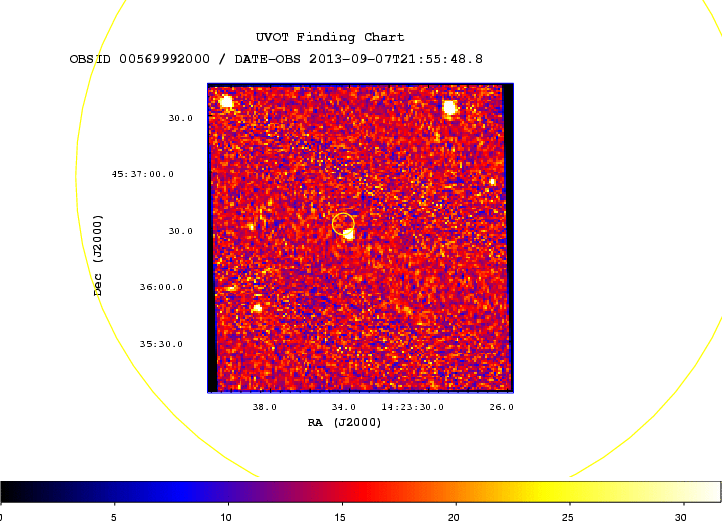
RA(J2000) = 14:23:34.08 Dec(J2000) = +45:36:26.7Using R-band values from nearby USNO stars, we get a magnitude R = 16.7 +- 0.1 at a mean time of 0.41 hr after the GRB, where the error is dominated by calibration uncertainties.
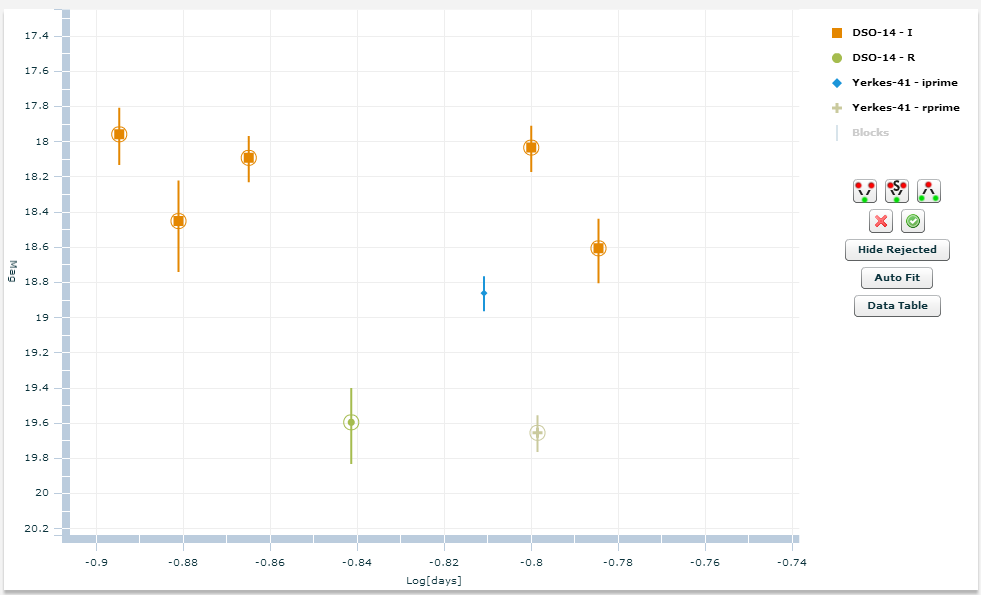
r =3D 20.01 +/- 0.03 i =3D 19.30 +/- 0.02 Z =3D 18.78 +/- 0.05 Y =3D 18.48 +/- 0.06 J =3D 18.13 +/- 0.06 H =3D 17.63 +/- 0.05These magnitudes are in the AB system and are not corrected for Galactic extinction in the direction of the GRB.
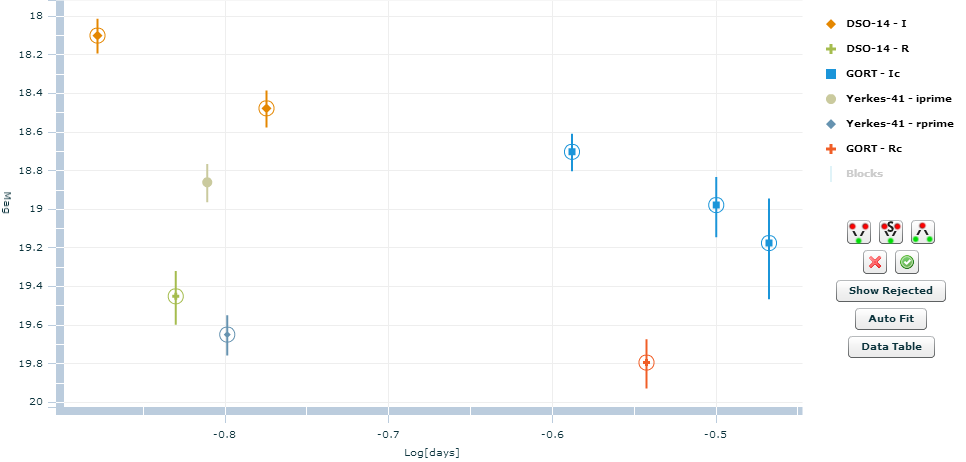
Time (d) Filter mag error 0.0152 Ic 15.26 0.03 0.0172 Rc 16.57 0.03not corrected for the very small reddening of 0.01 mag along the line of sight (Schlegel et al. 1998).
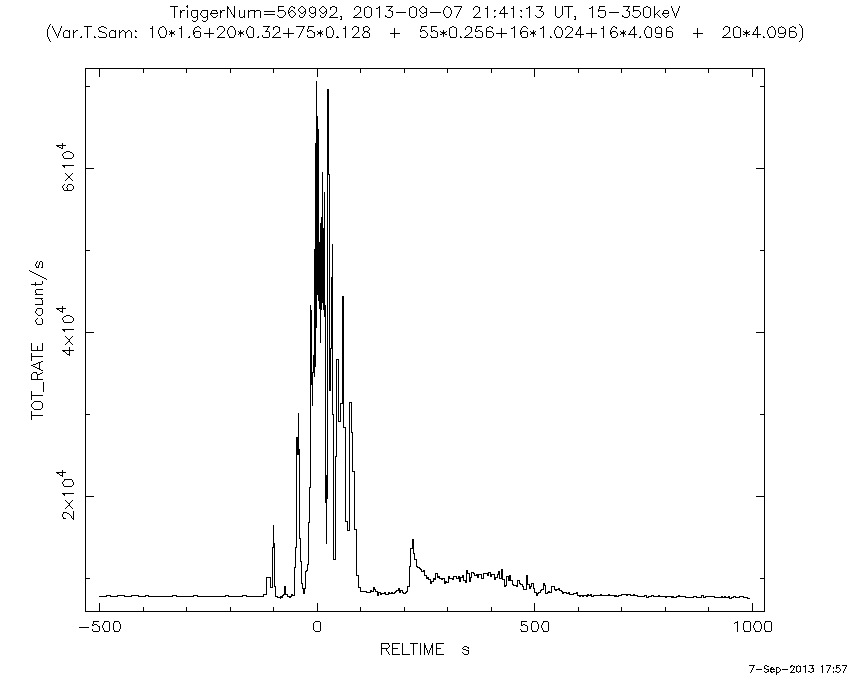
RA (J2000) = 14:23:34.04 = 215.89183 (deg.) Dec (J2000) = +45:36:27.1 = 45.60753 (deg.)with an estimated uncertainty of 0.50 arc sec. (radius, 90% confidence).
Filter T_start(s) T_stop(s) Exp(s) Mag white 74 224 147 15.45 +/- 0.02 v 616 636 20 16.29 +/- 0.16 b 542 562 20 16.78 +/- 0.12 u 286 536 246 15.87 +/- 0.04 w1 666 1113 117 18.54 +/- 0.31 m2 641 1606 117 >19.2 w2 592 786 38 >18.7The magnitudes in the table are not corrected for the Galactic extinction due to the reddening of E(B-V) = 0.01 in the direction of the burst (Schlegel et al. 1998).
RA (J2000): 14h 23m 34.12s Dec (J2000): +45d 36' 26.1"with an uncertainty of 1.4 arcsec (radius, 90% confidence).
Total column: 1.85 (+0.17, -0.16) x 10^21 cm^-2 Galactic foreground: 1.0 x 10^20 cm^-2 Excess significance: 17.7 sigma Photon index: 1.98 (+/-0.06)The results of the XRT-team automatic analysis are available at http://www.swift.ac.uk/xrt_products/00569992.
Tmid(h)+T0 Filter Exp. time Mag Mag err. 4.70 unfiltered 3x300 20.00CR 0.49 5.22 R 7x300 20.06R 0.47 5.77 unfiltered 3x300 20.36CR 0.47
RA(J2000) = 14h 23m 35.5s
Dec(J2000) = +45d 36' 08.0"
with an uncertainty of 1.0 arcmin, (radius, sys+stat, 90% containment).
The partial coding was 100%.
r 21.92 +/- 0.12 i 21.38 +/- 0.09 Z > 21.37 Y > 20.87 J > 20.58 H > 19.97These magnitudes are in the AB system and are not corrected for Galactic extinction in the direction of the GRB. The source has faded by about tw= o magnitudes in all bands since our measurements two nights ago (Lee et al.= , GCN 15192). We note that the source intensity in the r and i bands is no= w comparable to the cataloged values for the spatially coincident galaxy SD= SS J142333.95+453626.2.
r 22.40 +/- 0.14 i 21.73 +/- 0.10 Z > 21.80 Y > 21.05These magnitudes are in the AB system and are not corrected for Galactic extinction in the direction of the GRB. The source has faded by about 0.= 4 mags in the r and i bands relative to our observations last night (Butler et al., GCN 15208).
Table 1. ------- Start date and time exptime T_start-T_trig T_mid-T_trig P| mag. err_P P- mag err_P- P| + P- err. (P| + P-) -----------------------+--------+----------------+--------------+--------+---------+----------+---------+----------+--------------- 2013-09-07 21:42:00.31 10 47 52 <10.5 --- <10.5 --- <11.0 --- 2013-09-07 21:42:22.79 10 69 74 <10.5 --- <10.5 --- <11.0 --- 2013-09-07 21:42:43.59 20 91 101 <11.0 --- <11.0 --- <11.5 --- 2013-09-07 21:43:16.66 20 123 133 12.2 0.2 13.0 0.3 12.5 0.2 2013-09-07 21:43:47.44 30 154 169 13.3 0.4 13.6 0.6 13.5 0.4 2013-09-07 21:44:29.95 40 197 217 13.7 0.5 13.7 0.6 13.9 0.5 2013-09-07 21:45:21.88 50 249 274 13.7 0.5 14.4 0.8 14.0 0.6 2013-09-07 21:46:23.87 60+80 311 387 <13.8 --- <13.7 --- 13.9 0.6*) All time intervals in seconds. P| and P- is an unfiltered magnitude with RA and DEC orientated polaroid correspondingly. The sign '<' before magnitude means the value is upper limit.
r > 22.68 i > 22.62 Z > 21.30 Y > 20.70 J > 20.42 H > 19.69We conclude from our most constraining limit (i-band), that the source has faded by at least 0.9 mags since our observation 2 nights ago (Butler et al., GCN 15209). These magnitudes are now significantly fainter than the DR9 catalog magnitudes of SDSS galaxy mentioned by Lee et al.
RA(J2000) 14 23 34.01 Dec(J2000) +45 36 36.6with uncertainty of 0.18 arcsec in both coordinates.
t_start, filter Exposure, t-t0, OT (UT) sec mid,days 11:04:47 R 2*300 2.56166 21.44 +/- 0.16The photometry is based on a nearby SDSS-DR9 star J142338.63+453547.2 with R mag = 18.181 +/- 0.013 (transformation by Lupton 2005)